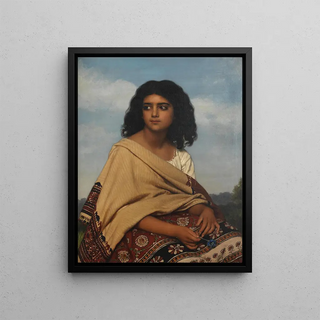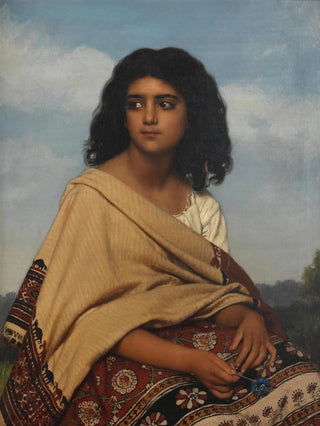Art print | Moza the Gypsy - Jozef Van Lerius


View from behind

Frame (optional)
Moza the Gypsy - Jozef Van Lerius – Captivating Introduction
In the vast panorama of art history, certain works manage to transcend eras and styles, captivating viewers with their depth and emotion. "Moza the Gypsy - Jozef Van Lerius" is one of these creations that, through its visual and narrative richness, transports us to a world where passion and culture intertwine. This piece, depicting a mesmerizing gypsy, embodies the free and indomitable spirit of a people, while offering a glimpse into daily life at the end of the 19th century. The portrayal of this female figure, both mysterious and charismatic, invites us to explore themes of identity, tradition, and artistic expression.
Style and uniqueness of the work
Jozef Van Lerius's work is distinguished by refined technique and meticulous attention to detail. The choice of colors, textures, and shapes creates a vibrant, almost tangible atmosphere. The gypsy, dressed in traditional costumes, is depicted in a pose that suggests both grace and strength. The interplay of light and shadow accentuates her facial features, revealing emotional depth that touches the viewer. This painting does not merely capture an image; it tells a story, that of a woman carrying the weight of her roots and the lightness of her dreams. The way Van Lerius plays with compositional elements, incorporating folkloric motifs, enhances the authenticity of the representation and invites prolonged contemplation.
The artist and his influence
Jozef Van Lerius, born in Belgium, established himself as a leading painter in the 19th century, notably through his skill in blending realism and romanticism. His fascination with popular cultures, especially that of the gypsies, allowed him to create works that resonate with universal humanity. Van Lerius was influenced by the Romantic movement, which sought to express deep emotions and human passions. Through his paintings, he explored various themes, but it is his ability to capture the

Matte finish

View from behind

Frame (optional)
Moza the Gypsy - Jozef Van Lerius – Captivating Introduction
In the vast panorama of art history, certain works manage to transcend eras and styles, captivating viewers with their depth and emotion. "Moza the Gypsy - Jozef Van Lerius" is one of these creations that, through its visual and narrative richness, transports us to a world where passion and culture intertwine. This piece, depicting a mesmerizing gypsy, embodies the free and indomitable spirit of a people, while offering a glimpse into daily life at the end of the 19th century. The portrayal of this female figure, both mysterious and charismatic, invites us to explore themes of identity, tradition, and artistic expression.
Style and uniqueness of the work
Jozef Van Lerius's work is distinguished by refined technique and meticulous attention to detail. The choice of colors, textures, and shapes creates a vibrant, almost tangible atmosphere. The gypsy, dressed in traditional costumes, is depicted in a pose that suggests both grace and strength. The interplay of light and shadow accentuates her facial features, revealing emotional depth that touches the viewer. This painting does not merely capture an image; it tells a story, that of a woman carrying the weight of her roots and the lightness of her dreams. The way Van Lerius plays with compositional elements, incorporating folkloric motifs, enhances the authenticity of the representation and invites prolonged contemplation.
The artist and his influence
Jozef Van Lerius, born in Belgium, established himself as a leading painter in the 19th century, notably through his skill in blending realism and romanticism. His fascination with popular cultures, especially that of the gypsies, allowed him to create works that resonate with universal humanity. Van Lerius was influenced by the Romantic movement, which sought to express deep emotions and human passions. Through his paintings, he explored various themes, but it is his ability to capture the






